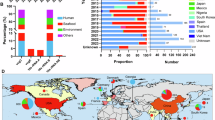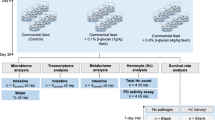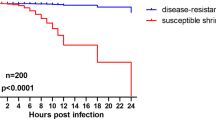Abstract
Vibrio nigripulchritudo is an emerging pathogen of farmed shrimp in New Caledonia and other regions in the Indo-Pacific. The molecular determinants of V. nigripulchritudo pathogenicity are unknown; however, molecular epidemiological studies have suggested that pathogenicity is linked to particular lineages. Here, we performed high-throughput sequencing-based comparative genome analysis of 16 V. nigripulchritudo strains to explore the genomic diversity and evolutionary history of pathogen-containing lineages and to identify pathogen-specific genetic elements. Our phylogenetic analysis revealed three pathogen-containing V. nigripulchritudo clades, including two clades previously identified from New Caledonia and one novel clade comprising putatively pathogenic isolates from septicemic shrimp in Madagascar. The similar genetic distance between the three clades indicates that they have diverged from an ancestral population roughly at the same time and recombination analysis indicates that these genomes have, in the past, shared a common gene pool and exchanged genes. As each contemporary lineage is comprised of nearly identical strains, comparative genomics allowed differentiation of genetic elements specific to shrimp pathogenesis of varying severity. Notably, only a large plasmid present in all highly pathogenic (HP) strains encodes a toxin. Although less/non-pathogenic strains contain related plasmids, these are differentiated by a putative toxin locus. Expression of this gene by a non-pathogenic V. nigripulchritudo strain resulted in production of toxic culture supernatant, normally an exclusive feature of HP strains. Thus, this protein, here termed ‘nigritoxin’, is implicated to an extent that remains to be precisely determined in the toxicity of V. nigripulchritudo.
Similar content being viewed by others
Log in or create a free account to read this content
Gain free access to this article, as well as selected content from this journal and more on nature.com
or
References
Austin B . (2010). Vibrios as causal agents of zoonoses. Vet Microbiol 140: 310–317.
Castresana J . (2000). Selection of conserved blocks from multiple alignments for their use in phylogenetic analysis. Mol Biol Evol 17: 540–552.
Cordero OX, Wildschutte H, Kirkup B, Proehl S, Ngo L, Hussain F et al (2012). Ecological populations of bacteria act as socially cohesive units of antibiotic production and resistance. Science 337: 1228–1231.
Daubin V, Gouy M, Perriere G . (2002). A phylogenomic approach to bacterial phylogeny: evidence of a core of genes sharing a common history. Genome Res 12: 1080–1090.
Edgar RC . (2004). MUSCLE: multiple sequence alignment with high accuracy and high throughput. Nucleic Acids Res 32: 1792–1797.
Finlay BB, Falkow S . (1997). Common themes in microbial pathogenicity revisited. Microbiol Mol Biol Rev 61: 136–169.
Goarant C, Ansquer D, Herlin J, Domalain F, Imbert F, de Decker S . (2006a). ‘Summer syndrome’ in litopenaeus stylirostris in New Caledonia: pathology and epidemiology of the etiological agent, Vibrio nigripulchritudo. Aquaculture 253: 105–113.
Goarant C, Reynaud Y, Ansquer D, de Decker S, Saulnier D, le Roux F . (2006b). Molecular epidemiology of Vibrio nigripulchritudo, a pathogen of cultured penaeid shrimp (Litopenaeus stylirostris) in New Caledonia. Syst Appl Microbiol 29: 570–580.
Guindon S, Dufayard JF, Lefort V, Anisimova M, Hordijk W, Gascuel O . (2010). New algorithms and methods to estimate maximum-likelihood phylogenies: assessing the performance of PhyML 3.0. Syst Biol 59: 307–321.
Hoffmann M, Monday SR, Allard MW, Strain EA, Whittaker P, Naum M et al (2012). Vibrio caribbeanicus sp. nov., isolated from the marine sponge Scleritoderma cyanea. Int J Syst Evol Microbiol 62: 1736–1743.
Huerta-Cepas J, Dopazo J, Gabaldon T . (2010). ETE: a python environment for tree exploration. BMC Bioinformatics 11: 24.
Hurst MR, Beard SS, Jackson TA, Jones SM . (2007). Isolation and characterization of the Serratia entomophila antifeeding prophage. FEMS Microbiol Lett 270: 42–48.
Hurst MR, Glare TR, Jackson TA . (2004). Cloning Serratia entomophila antifeeding genes—a putative defective prophage active against the grass grub Costelytra zealandica. J Bacteriol 186: 5116–5128.
Kroken S, Glass NL, Taylor JW, Yoder OC, Turgeon BG . (2003). Phylogenomic analysis of type I polyketide synthase genes in pathogenic and saprobic ascomycetes. Proc Natl Acad Sci USA 100: 15670–15675.
Le Roux F, Binesse J, Saulnier D, Mazel D . (2007). Construction of a Vibrio splendidus mutant lacking the metalloprotease gene vsm by use of a novel counterselectable suicide vector. Appl Environ Microbiol 73: 777–784.
Le Roux F, Labreuche Y, Davis BM, Iqbal N, Mangenot S, Goarant C et al (2011). Virulence of an emerging pathogenic lineage of Vibrio nigripulchritudo is dependent on two plasmids. Environ Microbiol 13: 296–306.
Medema MH, Blin K, Cimermancic P, de Jager V, Zakrzewski P, Fischbach MA et al (2011). AntiSMASH: rapid identification, annotation and analysis of secondary metabolite biosynthesis gene clusters in bacterial and fungal genome sequences. Nucleic acids Res 39: W339–W346.
Nosanchuk JD, Casadevall A . (2003). The contribution of melanin to microbial pathogenesis. Cell Microbiol 5: 203–223.
Pimenta AL, Racher K, Jamieson L, Blight MA, Holland IB . (2005). Mutations in HlyD, part of the type 1 translocator for hemolysin secretion, affect the folding of the secreted toxin. J Bacteriol 187: 7471–7480.
Pond FR, Gibson I, Lalucat J, Quackenbush RL . (1989). R-body-producing bacteria. Microbiol Rev 53: 25–67.
Raymann K, Bobay LM, Doak TG, Lynch M, Gribaldo S . (2013). A genomic survey of reb homologs suggests widespread occurrence of R-bodies in proteobacteria. G3 (Bethesda) 3: 505–516.
Reen FJ, Almagro-Moreno S, Ussery D, Boyd EF . (2006). The genomic code: inferring Vibrionaceae niche specialization. Nat Rev Microbiol 4: 697–704.
Reynaud Y, Saulnier D, Mazel D, Goarant C, Le Roux F . (2008). Correlation between detection of a plasmid and high-level virulence of Vibrio nigripulchritudo, a pathogen of the shrimp Litopenaeus stylirostris. Appl Environ Microbiol 74: 3038–3047.
Sakai T, Hirae T, Yuasa K, Kamaishi T, Matsuyama T, Miwa S et al (2007). Mass mortality of cultured kuruma prawn Peneaus japonicus caused by Vibrio nigripulchritudo. Fish Pathol 42: 141–147.
Schrallhammer M, Galati S, Altenbuchner J, Schweikert M, Gortz HD, Petroni G . (2012). Tracing the role of R-bodies in the killer trait: absence of toxicity of R-body producing recombinant E. coli on paramecia. Eur J Protistol 48: 290–296.
Staunton J, Weissman KJ . (2001). Polyketide biosynthesis: a millennium review. Nat Prod Rep 18: 380–416.
Thompson FL, Iida T, Swings J . (2004). Biodiversity of vibrios. Microbiol Mol Biol Rev 68: 403–431 (table of contents).
Vallenet D, Engelen S, Mornico D, Cruveiller S, Fleury L, Lajus A et al (2009). MicroScope: a platform for microbial genome annotation and comparative genomics. Database (Oxford) 2009: bap021.
Waterfield NR, Wren BW, Ffrench-Constant RH . (2004). Invertebrates as a source of emerging human pathogens. Nat Rev Microbiol 2: 833–841.
Wozniak RA, Waldor MK . (2010). Integrative and conjugative elements: mosaic mobile genetic elements enabling dynamic lateral gene flow. Nat Rev Microbiol 8: 552–563.
Zerbino DR, Birney E . (2008). Velvet: algorithms for de novo short read assembly using de Bruijn graphs. Genome Res 18: 821–829.
Ziemert N, Podell S, Penn K, Badger JH, Allen E, Jensen PR . (2012). The natural product domain seeker NaPDoS: a phylogeny based bioinformatic tool to classify secondary metabolite gene diversity. PLoS One 7: e34064.
Acknowledgements
We acknowledge Dr Eliane Chung and Iony Manitra Razanajatovo for providing the strains isolated in Madagascar, Sophie Le Panse for the transmission electron microscopy analysis, the staff of the station Ifremer Nouvelle Calédonie, the ABIMS and LABGeM plateform for technical support, Dr Simonetta Gribaldo, Otto Cordero and Dr Cyrille Goarant for fruitful discussions and Dr Brigid Davis for critical reading of the manuscript. The present study has been supported by the Genoscope (appel d’offre 2007 and 2011) Region Bretagne (SAD Vibrigen 6633), the Institut Pasteur, the CNRS (UMR3525), the ANR blanc (11-BSV7-023-01 ‘VIBRIOGEN’) and Ifremer (DG post doctoral funding).
Author information
Authors and Affiliations
Corresponding author
Additional information
Supplementary Information accompanies this paper on The ISME Journal website
Supplementary information
Rights and permissions
About this article
Cite this article
Goudenège, D., Labreuche, Y., Krin, E. et al. Comparative genomics of pathogenic lineages of Vibrio nigripulchritudo identifies virulence-associated traits. ISME J 7, 1985–1996 (2013). https://doi.org/10.1038/ismej.2013.90
Received:
Revised:
Accepted:
Published:
Issue date:
DOI: https://doi.org/10.1038/ismej.2013.90
Keywords
This article is cited by
-
Comparative genomic analysis of Vibrios yields insights into genes associated with virulence towards C. gigas larvae
BMC Genomics (2020)
-
Melanin biosynthesis in bacteria, regulation and production perspectives
Applied Microbiology and Biotechnology (2020)
-
Ancestral gene acquisition as the key to virulence potential in environmental Vibrio populations
The ISME Journal (2018)
-
Maintenance of multipartite genome system and its functional significance in bacteria
Journal of Genetics (2018)
-
Nigritoxin is a bacterial toxin for crustaceans and insects
Nature Communications (2017)



